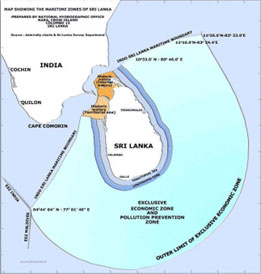PATHFINDER NATIONAL SECURITY BRIEF -03
Sri Lanka’s strategic location in the Indian Ocean, along the vital East-West shipping lanes connecting the Straits of Hormuz, Bab el-Mandeb, and Malacca, grants the country considerable geopolitical and economic significance. With a vast maritime territory that includes a territorial sea of 21,500 km², an Exclusive Economic Zone (EEZ) spanning nearly eight times its landmass of 65,610 km², and a coastline extending 1,340 km, Sri Lanka stands as a key maritime hub in the region. This strategic advantage also exposes the country to an increasingly complex and evolving maritime security environment. The Nation’s economy and security are closely linked to the protection of this maritime domain, which encompasses vital sectors such as fisheries, trade and tourism. Maritime Domain Challenges (MDR) range from traditional threats to more complex and evolving issues, including Illegal, Unreported, and Unregulated (IUU) fishing, human trafficking, drug trafficking, arms trafficking, maritime terrorism, and cyber threats to critical infrastructure. In today’s rapidly evolving security landscape, leveraging advanced technology is crucial to safeguard the country’s strategic and economic interests, foster greater regional cooperation, and contribute to long-term maritime stability and shared economic resilience
 Source: National Hydrographic Office, NARA, Colombo/ Admiralty Charts & Sri Lanka Survey Department.
Source: National Hydrographic Office, NARA, Colombo/ Admiralty Charts & Sri Lanka Survey Department.
Evolving Maritime Security Landscape
For an island nation like Sri Lanka, positioned at a strategically vital sea lane in the Indian Ocean, the evolving maritime security landscape holds heightened significance. Historically, the country’s maritime security concerns were rooted in traditional threats that disrupted trade routes, endangered seafarers, and undermined coastal stability. However, the contemporary maritime environment has grown increasingly complex in recent years. It now encompasses a broad range of non-traditional, transnational challenges such as IUU fishing, human and drug trafficking, maritime terrorism, cyber threats, and environmental hazards. These threats are often asymmetric in nature, defying conventional military responses and requiring more adaptive, technologically driven cooperative security strategies.
IUU Fishing: IUU fishing poses a serious threat to Sri Lanka’s marine biodiversity, the livelihood of coastal communities and food security. The country’s rich fisheries resources are increasingly being exploited by unauthorised foreign vessels, resulting in overfishing, degradation of vital marine ecosystems and negative economic impacts. Sri Lanka must assert effective control over its EEZ to prevent resource exploitation by unlicensed foreign vessels and to develop sustainable economic ventures within this maritime expanse through advanced digitised programs. Effectively addressing these complex and evolving maritime security challengers is vital for the country’s security, economic and regional stability.
Transnational Criminal Activities: Increased, transnational criminal activities in the maritime domain continue to pose a significant challenge to public safety and national security. Approximately 700kg of drugs, including 280kg of Heroin and 420kg of ICE, valued at over 9 billion Sri Lankan rupees, along with five pistols and a T-56 weapon, were recovered from three lorries in Tangalle, a southern town, on 22 September 2025 by the police. The Sri Lanka Navy (SLN) seized approximately 250kg of heroin and methamphetamine valued at over 3 billion Sri Lankan rupees and approximately 45kg of heroin from fishing trawlers on the high seas in January and November 2024, respectively. Moreover, in the same year, the SLN rescued 115 foreign nationals from a fishing trawler off the Eastern coast, suspected to be part of an international human trafficking network. These incidents clearly highlight the persistent threat posed by drugs and human trafficking syndicates operating in the extended waters of Sri Lanka. While maritime terrorism has not prominently manifested in Sri Lankan waters, rising global and regional trends in maritime extremism highlight it as a potential threat to national security
Cyber Threats: As a vital maritime hub in the Indian Ocean, the country’s shipping, port operations and maritime logistics sectors increasingly rely on digital technologies. While the digitalisation of the maritime sector enhances operational efficiency, it also exposes the industry to a growing range of cyber threats, such as ransomware attacks, data breaches, and system disruptions. Such attacks have the potential to disrupt port operations and compromise sensitive information, causing substantial economic losses and heightened national security risks. In 2023, “DP World”, operator of key ports across Australia, was hit by a cyberattack, causing significant disruption for its cargo operations, resulting in substantial economic losses. Although Sri Lanka has not yet experienced a major cyber-attack on its port infrastructures as of today, these incidents highlight the growing vulnerabilities in the maritime domain and provide a clear warning to the country’s maritime infrastructure.
EEZ Governance Gaps: Sri Lanka’s EEZ represents a critical extension of its sovereign rights and maritime jurisdiction. The EEZ holds economic, ecological, and strategic importance, encompassing vital resources including fisheries, hydrocarbons, and marine biodiversity. However, this zone remains under-monitored and under-exploited. The December 2023 moratorium on foreign research vessels demonstrates growing concerns over research activities in Sri Lankan waters, posing an ongoing challenge to the government to enforce stronger maritime governance and ensure sustainable management of ocean resources. Strategic surveillance, cooperative regional frameworks, and investment in maritime scientific research are essential to transforming Sri Lanka’s EEZ into a pillar of national economic and environmental security.
Environmental Hazards: Environmental security has also become an increasingly critical aspect of Sri Lanka's maritime security landscape, given the country’s high vulnerability to natural disasters such as cyclones, floods, droughts, and landslides, as well as man-made disasters, which affect coastal communities and their livelihoods. The MV X-Press Peral disaster in 2021 highlighted the devastating consequences of marine pollution on the country’s coastal ecosystems, fisheries, and public health. Moreover, the long-term impact of climate change, including rising sea levels, coastal erosion, and extreme weather events, poses significant risks to maritime infrastructure and the resilience of island communities.
Strategic Competition: Strategic competition in the Indian Ocean Region (IOR) has intensified as major powers increasingly seek to assert their influence over this crucial maritime space. The presence of various naval forces representing major maritime powers, as well as mini-lateral initiatives and growing military infrastructure in the IOR, has intensified the complexity of the strategic landscape. Additionally, major powers have also sought control of critical chokepoints leading to the Indian Ocean and built strategic partnerships with littoral nations to secure their support with the primary aim of securing the Indian Ocean's Sea Lines of Communication (SLOCs). Concerning Sri Lanka, the intensifying geopolitical competition among major powers places the country in a delicate balancing act, compelling it to take measures to safeguard its national interests.
Integration of Emerging Technologies
As regional waters become increasingly contested and maritime crimes become more sophisticated, rapid detection and response capabilities are vital. Addressing these multifaceted threats requires not only traditional naval capabilities but also the integration of advanced technologies, such as surveillance systems, automated radar, and data analytics, to enhance maritime domain awareness (MDA). Enhanced MDA enables Sri Lanka to monitor its surrounding seas in real-time with greater accuracy.
The enhanced coordination through Data Fusion Centres (DFC) is vital, where information from multiple sources is collected and analysed into a comprehensive operational picture, enabling coordinated responses across agencies and national boundaries. Moreover, such coordination will be critical, particularly when dealing with maritime incidents, where timely unified action determines whether the situation is contained or escalates.
Through integration of digital communication platforms and shared data collaboration, the SLN, Coast Guard, Port authorities, and Fishers Department can operate more cohesively and efficiently. Technologies such as satellite surveillance, automated radar systems, and automated monitoring platforms provide vital data to centralised command centres, not only enhancing the detection of suspicious activities but also enabling effective coordination among maritime agencies to address evolving threats.
While traditional naval patrols remain essential, they alone cannot effectively monitor the country’s vast EEZ. Unmanned Aerial Vehicles (UAVs) with long-range surveillance capabilities will be able to fill these vacuums, allowing authorities to keep an eye on large areas vulnerable to illegal fishing, human trafficking, and narcotic trafficking and respond in the shortest possible time.
Expanding the use of AI-based analytics in maritime surveillance is becoming increasingly vital. With the growing volume of data generated from ship movements to environmental changers, AI tools can not only enhance real-time threat detection capabilities and strategic decision making but also improve overall MDA.
Moreover, environmental monitoring capabilities linked to satellite technology play a vital role in preventing and mitigating marine pollution and also support conservation efforts essential for protecting Marine biodiversity and sustainable coastal livelihood.
Looking Ahead Pathfinder Recommendations
For Sri Lanka, the future of maritime security depends on smart integration, strategic partnerships and a coherent long-term vision. While strengthening institutional capacity and operational capabilities, particularly the Coast Guard, through advanced technology integration, entails significant costs, it will constitute a strategic investment essential for safeguarding the country’s economic and security interests. Yet, long-term resilience will stem from investing in skilled human capital, fostering inter-agency and intra-agency coordination, strengthening Public-Private Partnerships, and promoting innovation across institutions. By aligning technological advancement with national security priorities, Sri Lanka can not only safeguard its maritime interests but also position itself as a resilient and proactive maritime nation capable of addressing emerging regional challengers.
(This is the ‘PATHFINDER NATIONAL SECURITY BRIEF -03, issued by the Pathfinder Foundation. NATIONAL SECURITY BRIEF articles can be read https://pathfinderfoundation.org, and Readers’ comments via email to This email address is being protected from spambots. You need JavaScript enabled to view it. are welcome.)

Leave your comments
Login to post a comment
Post comment as a guest